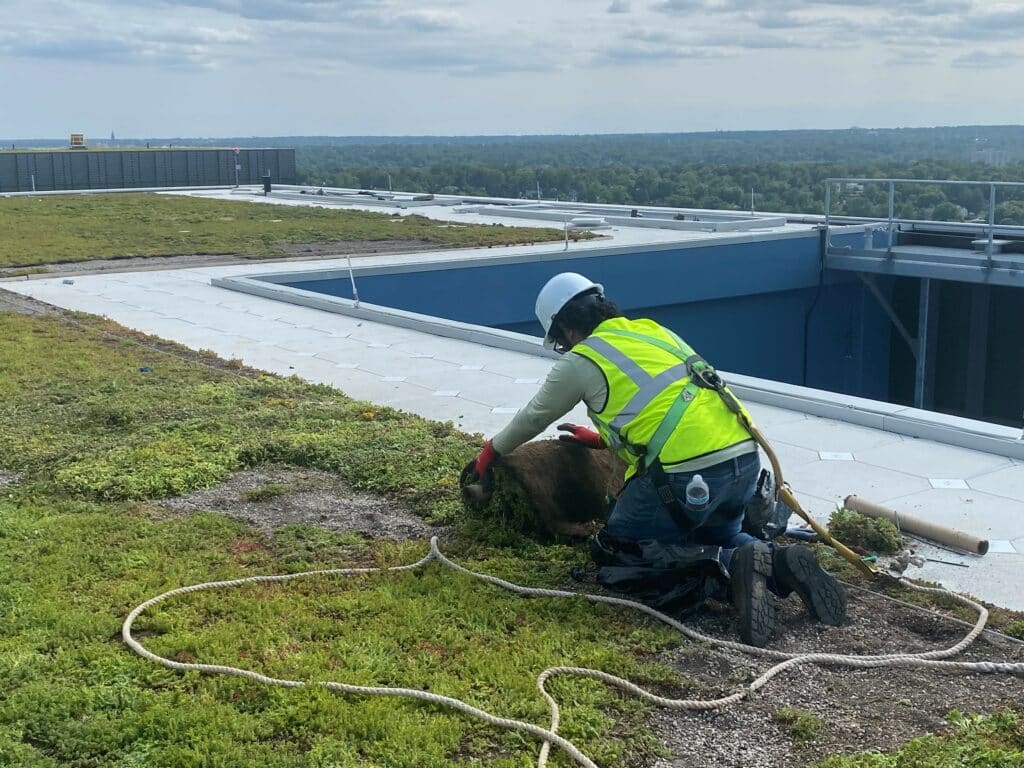Understanding Green Roof Systems
A green roof system is a sustainable roofing solution that incorporates living vegetation on top of traditional roofing materials. It is designed to create an eco-friendly layer that not only improves building aesthetics but also provides numerous environmental benefits. Green roofs work by layering waterproof membranes, soil, and plants, which together support plant life while protecting the building structure. Unlike conventional roofs, green roofs can absorb rainwater, reduce heat, and improve air quality. The system is versatile, suitable for residential, commercial, and urban settings, making it a growing trend in sustainable architecture. It also promotes biodiversity by providing a habitat for birds, insects, and pollinators within urban landscapes. Implementing a green roof system can significantly enhance the overall functionality and resilience of a building.
Types of Green Roof Systems
Green roofs are classified into three main types, each designed to meet different needs. Extensive green roofs are lightweight and low-maintenance, typically featuring shallow soil and hardy plants like sedum or grasses. These are ideal for residential or commercial buildings looking for minimal upkeep. Intensive green roofs, on the other hand, are more elaborate, resembling traditional gardens, and can support shrubs, trees, and deeper soil layers. Semi-intensive green roofs combine features of both types, offering moderate plant variety and maintenance requirements. Each type comes with specific considerations such as weight, irrigation needs, and installation costs. Choosing the right system depends on the building structure, budget, and intended use. Comparisons of types often weigh long-term benefits against initial investment and maintenance requirements.
Key Components of a Green Roof System
The effectiveness of a green roof system relies on its core components. The waterproof membrane prevents water from penetrating the building structure. A root barrier layer ensures plant roots do not damage the membrane. Drainage and water retention layers manage excess water and help maintain soil moisture. The growing medium, or soil, must be lightweight yet nutrient-rich to support plant health. Finally, the vegetation layer provides the aesthetic and environmental benefits, with plants selected based on climate, sunlight, and maintenance levels. Proper integration of these layers ensures the green roof system functions efficiently while extending the roof’s lifespan. Each component plays a critical role in both performance and sustainability.
Environmental and Economic Benefits
Green roofs deliver significant environmental and financial advantages. They help mitigate the urban heat island effect by cooling surrounding areas. The vegetation improves air quality, trapping dust and pollutants while producing oxygen. Energy efficiency is enhanced as green roofs insulate buildings, reducing heating and cooling costs. Stormwater management is another major benefit, with the system absorbing rainfall and reducing runoff, which helps prevent flooding. Additionally, green roofs contribute to building longevity by protecting the underlying roof from UV damage and temperature extremes. Economically, property value can increase due to the appeal of a sustainable and visually attractive roof system. Implementing a green roof system offers a tangible return on investment over time.
Installation Process
Installing a green roof system requires careful planning and professional assessment. The process starts with evaluating the building structure to ensure it can handle the additional weight. Proper design includes selecting the type of green roof, soil, plants, and irrigation system. Installation follows a layered approach, beginning with the waterproof membrane, then the root barrier, drainage layers, growing medium, and finally, planting. Irrigation and maintenance systems may also be integrated during installation to support plant health. Common challenges include ensuring proper drainage and selecting plants suited to local climate conditions. Addressing these issues during installation prevents future maintenance problems and ensures the roof performs as intended.
Maintenance and Longevity
Maintaining a green roof system is essential for its long-term success. Routine tasks include weeding, checking irrigation systems, and monitoring plant health. Seasonal maintenance varies depending on climate, with additional watering during dry months and debris removal in fall. Structural checks ensure the drainage system functions properly and prevents water accumulation. Fertilization may be required periodically to maintain soil nutrients. Healthy maintenance practices extend the roof’s lifespan and optimize energy savings. Proper attention to these tasks ensures the green roof system continues to provide environmental and economic benefits over many years.
Green Roof Systems in Urban Planning
Green roofs are increasingly integrated into urban planning strategies. They are a key component of sustainable architecture and smart city designs. Cities that encourage green roofs provide incentives, grants, or regulatory benefits to promote widespread adoption. These systems help manage stormwater, reduce heat islands, and improve air quality, contributing to overall urban resilience. By creating green spaces in densely populated areas, green roofs enhance community well-being and provide recreational areas. Collaboration between urban planners, architects, and building owners is crucial for successful implementation. Green roof systems are now considered essential in the development of sustainable and eco-friendly urban landscapes.
Cost Considerations and ROI
While green roofs may have higher upfront costs than traditional roofs, the long-term benefits often outweigh the initial investment. Costs vary depending on roof size, type, plants, soil, and irrigation systems. Extensive green roofs are generally more affordable, whereas intensive systems require higher investment due to deeper soil and heavier plantings. The return on investment comes from energy savings, longer roof life, improved property value, and potential tax incentives or grants. Maintenance costs should also be considered but are often lower than anticipated for extensive systems. Careful planning and cost analysis ensure the green roof system is both economically viable and environmentally beneficial.
Future Trends in Green Roof Technology
Green roof technology continues to evolve, integrating innovative designs and smart systems. Combining green roofs with solar panels is becoming more common, enhancing energy efficiency. Advanced irrigation systems use sensors to monitor soil moisture and adjust watering automatically. Lightweight soils and drought-resistant vegetation are also trending, reducing structural load and maintenance requirements. Innovations in modular green roofs allow easier installation and flexibility for urban applications. As sustainability becomes a central focus, green roof systems are expected to play a larger role in architecture and urban development. These trends ensure green roofs remain a practical and attractive solution for modern buildings.
FAQ
- What is the lifespan of a green roof system?
A well-maintained green roof system can last 30 to 50 years, significantly longer than traditional roofs due to the protective vegetation layer. - Can green roofs support trees and heavy vegetation?
Yes, intensive green roofs can support larger plants and even small trees, provided the building structure is designed to handle the additional weight. - How much maintenance is required for a green roof?
Maintenance depends on the type of green roof. Extensive roofs require minimal upkeep, while intensive roofs need regular watering, pruning, and plant care. - Are green roofs suitable for all types of buildings?
Most buildings can support green roofs, but a structural assessment is necessary to ensure the roof can handle the added weight and irrigation system. - How do green roofs impact property value?
Green roofs increase property value by enhancing aesthetics, providing energy savings, and demonstrating sustainable building practices, making properties more attractive to buyers or tenants.
Takeaway
A green roof system is a powerful tool for sustainable building, offering environmental, economic, and aesthetic benefits. By reducing energy costs, managing stormwater, and improving urban air quality, it transforms rooftops into functional green spaces. Proper planning, installation, and maintenance are key to maximizing these benefits. With evolving technologies and growing urban sustainability initiatives, green roofs are set to become an integral part of future architecture and city planning. Adopting a green roof system not only enhances a building’s performance but also contributes to a healthier, more sustainable urban environment.






